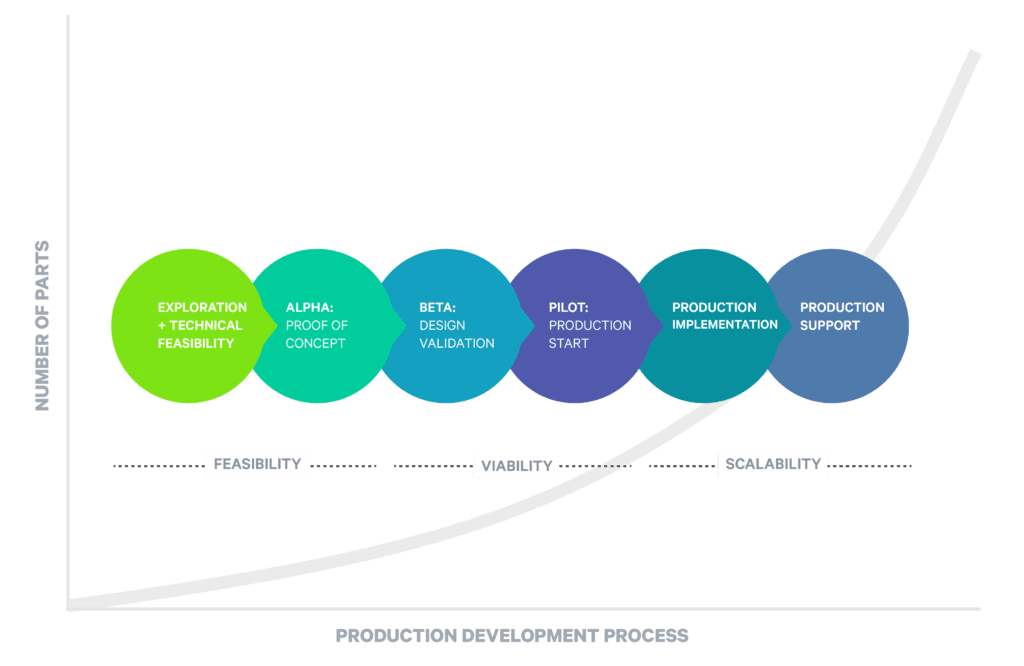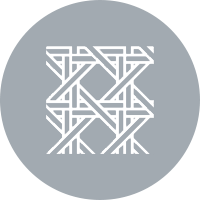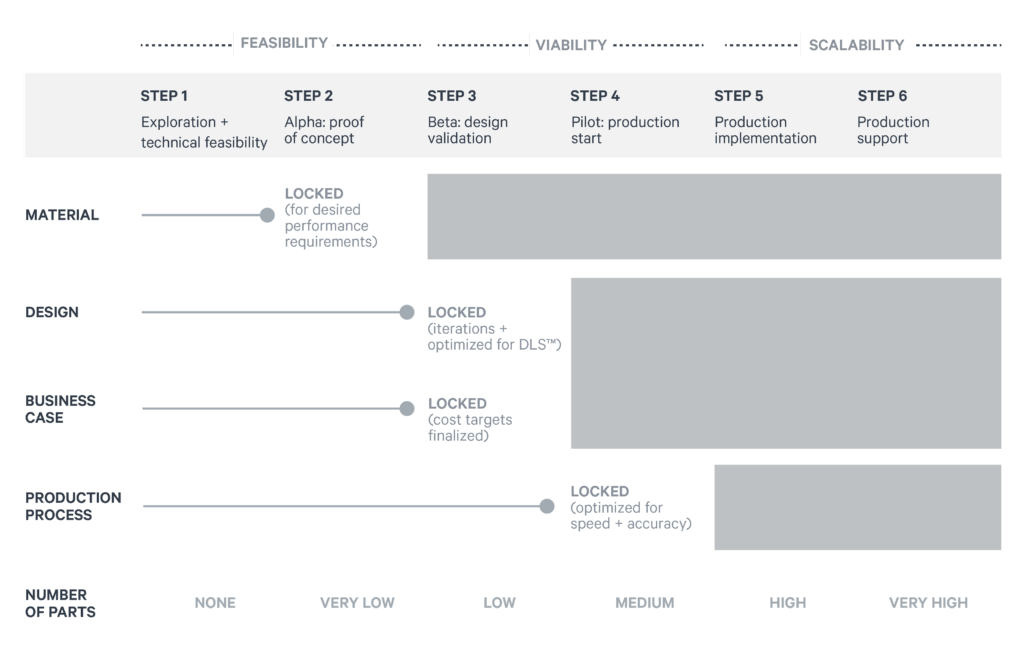Introduction
The ability to learn a new manufacturing technology, test its feasibility, validate its viability, and integrate into the existing business processes to scale production requires a step-by-step approach (Figure 1). While overall process timelines depend on the sophistication of the customer’s product and how the 3D-manufactured part(s) integrate into the end-use product, Carbon’s DLS™-powered process is significantly faster compared to processes that use traditional manufacturing technologies. Implementation of this product development process by some of our medium and large OEM customers led to significant decreases in production timelines—a testament to its effectiveness.

The Six-Step Process
According to Deloitte, worldwide spending on 3D printing will reach almost $20B by 20201. Additionally, research done by McKinsey Global Institute states that the adoption of 3D printing could have a global economic impact of up to $550B a year by 20252. However, in spite of all the excitement around 3D printing, there is still limited knowledge about the technology, its capabilities, and how to adopt and integrate 3D printing into organizations’ design processes and production processes. Carbon’s six-step journey to production guides our partners through the DLS product development process, from concept to manufacturing.
“Business and technology leaders are encouraged to map Carbon’s production development process to their existing product development cycles and identify what opportunities lie ahead as they integrate this 3D Manufacturing approach into their existing workflows.”
In this white paper, Carbon’s partnerships highlight how the six-step process was implemented to bring DLS parts into production. The majority of time acceleration is enabled at steps 2 and 3 due to the speed and ease of conducting design iterations using Carbon’s DLS technology. Dedicated application engineering resources, production-ready materials, and innovative software tools provide an unparalleled flexibility to carry out design iterations rapidly. Additionally, the process effectiveness is catalyzed by organizational alignment between the customer and Carbon, an aspect the process reinforces at every step along the way.
Every application is unique. Durations listed are optimal situations; at every step, Carbon has worked with customers at the fastest side of the engagement as well as significantly longer, depending on the breadth of exploration then depth and breadth of qualification. Contact Carbon for assistance in developing your own timeline.
Step 1: Feasibility Stage
Exploration + technical feasibility

Goal
Identify applications and customer part(s) to prove technical feasibility with minimal resources.
Process
Carbon works in close collaboration with the OEM customer to explore and identify potential part(s) that can leverage Carbon DLS technology. Part ideation is typically carried out in a cross-functional workshop setup with engineering, manufacturing leadership, and business leadership.
Duration
2-4 weeks per part design
Exploration Example:
Automotive OEM Workshop
A global automotive OEM wanted to find their best applications to bring to Carbon. They started by understanding the technology, requesting a Carbon expert to lead a workshop. At that workshop, they brought together cross-functional stakeholders to brainstorm the best parts to design and produce, then established their own criteria for which projects to move forward with.
Step 2: Feasibility Stage
Alpha stage + proof of concept

Goal
Carbon delivers an early proof of concept and confirms design(s) for DLS can achieve the performance requirements by producing a small number of samples.
Process
Among the part(s) identified in step 1 as feasible, this stage involves Carbon working on part(s) design to deliver an early proof of concept. Preliminary part(s) cost estimates are developed by Carbon to ensure costs are within the customer’s budgetary constraints. The customer shares the original design files with Carbon (if needed) to work and redesign for DLS. The material family used for the part(s) is typically finalized at this stage with performance requirements in mind. Between 5 and 30 parts per application are printed and tested.
Compared to 6 to 23 weeks per design iteration with injection molding, the Carbon application engineering team can provide a proof of concept to customers in just 1 to 3 weeks, almost 50% to 80% less time.
Duration
1-3 weeks per part design
Alpha Examples:
Consumer Goods
Based in high potential part ideations from the Exploration stage, Carbon delivered early proof of concepts to a sporting goods manufacturer. These lattice samples proved that Carbon’s elastomer EPU material could meet key performance requirements and stress-strain profile set by the customer. Finally, Carbon identified all open product requirements and captured potential opportunities to improve manufacturability to explore in Beta.
Vitamix
Carbon, The Technology House (TTH), and Vitamix collaborated and redesigned Vitamix’s original part design for DLS by consolidating it from six parts into a single 3D-printed component. This proof of concept proved the single part could meet the same key performance requirements of the original assembly. The material passed material and environmental requirements, demonstrating readiness for Beta.
Step 3: Viability Stage
Beta stage – design validation

Goal
Finalize the design and confirm functional and commercial viability with 30 – 100 parts.
Process
Among the part(s) that passed proof of concept stage, this step involves locking the part design and carrying out any design iterations (as needed). The customer is expected to complete functional part(s) testing to ensure viability of the solution. Additionally, a detailed cost model is shared with the customer to ensure the business case of manufacturing with DLS is viable. Process capability topics such as variations within the build platform, printer to printer, and resin-lot to resin-lot are qualified and optimized at this stage. Carbon DLS technology enables rapid product design iterations with quick turnaround times. Again, compared to 6 to 23 weeks per design iteration with injection molding. Carbon’s approach requires only 1 – 3 weeks per design iteration.
Duration
1-3 weeks per design iteration
Beta Example:
Aptiv Dust Caps
Aptiv’s primary concern in manufacturing was repeatability. With the part locked and critical tolerances identified, Carbon rigorously tested across major sources of variation, including variation within a print, printer-to-printer, and across resin batches. With that print data, Aptiv confirmed DLS met their stringent military specs and standards.
Step 4: Viability Stage
Pilot – Low volume production

Goal
Confirm printability, efficiency, and economics over 100-1,000 parts and multiple printers.
Process
With production in sight, process capability is confirmed over many parts and multiple machines. The focus is on the end-to-end process from mixing to bake, to achieve the yield, uptime, throughput, and economic targets required by the part(s). Carbon helps optimize process development for speed and/or accuracy as the customer requires, and production transition plans are discussed with the customer (OEM or contract manufacturer(CM)). It is important to note that any product design issues discovered this late can still be addressed and fixed given the flexibility of Carbon’s DLS technology and digital approach to manufacturing.
Duration
Typically 2 to 6 weeks, could be more depending on the complexity of the process and unforeseen process optimization challenges.
Pilot Example:
BMW Side Scuttle
BMW offers mass customization of a side scuttle and wanted to understand variation across many dimensions not captured in Beta. During the pilot, Carbon captured other key data in the process, the optimized the entire process for speed and accuracy, resulting in higher yields and repeatability across the entire process.
Step 5: Scalability Stage
Production implementation

Goal
Transfer proven production process to the OEM/CM, replicate efficiency and throughput proven at Carbon.
Process
Complete pre-production runs are carried out at the OEM or CM facility. The key deliverable in this step is to replicate efficiency, yield, and throughout previously proven at Carbon. Carbon provides all necessary guidance to the OEM or CM as needed. Carbon engineering resources are also made available for on-site help and troubleshooting for a smooth transition.
Duration
Typically 2 to 6 weeks, could be more depending on the complexity of the process and unforeseen process optimization challenges.
Production Implementation Example:
Aptiv Dust Cap to TTH
Carbon handed TTH (CM) Aptiv’s locked production parameters that were defined in the preceding steps and included the print data from the Pilot step. The success of the handoff was validated by TTH’s ability to replicate the efficiency, yield, and throughput in their own pre-production runs that Carbon had proved earlier and set as the clearly defined standards. Throughout that production handoff and ramp to production with TTH, Carbon provided support in the form of onsite help and troubleshooting the make the transition as smooth as possible.
Step 6: Scalability Stage
Production support

Goal
OEM or CM ramps up production and delivers part(s) output goals.
Process
In this last stage, the OEM or CM ramps up production independently and is able to meet output goals for the 3D-manufactured part(s). At this stage, Carbon plays a supporting role and helps with troubleshooting or solving unforeseen technical challenges only. The customer and Carbon can now look back and build on the success of this engagement to start worting on the next part(s).
Duration
Depends on the complexity of production process, geography, and number of production sites.
Production Support Example:
Aptiv Carbon Production Network Support
Aptiv, through TTH, is currently delivering their part output goals, with the external infrequent help of Carbon’s customer service and support. Network-connected printers and software ensure real-time, direct support from Carbon technical partners so customers can maximize their machine uptime and continuously improve their parts. Aptiv is now independently working on their next product innovation using the same steps to production outlined previously.
Summary
Carbon’s six-step production process is currently being leveraged by medium- to large-enterprise customers in consumer goods, automotive, life sciences, and industrial segments. These companies are creating highly complex and differentiated digitally manufactured parts previously unthinkable with traditional manufacturing technologies. Working in close partnership with our customers, Carbon has developed a robust process that can significantly reduce time to market for new products, depending on the complexity of the process, complexity of the part(s), and the ability of all stakeholders to align on the key deliverables around material, design, business, and the production process as highlighted below (Figure 2).

As a product and engineering leader, if you are looking to embark on the 3D Manufacturing journey and are seeking a partner who supports you every step of the way, drop us a note at sales@carbon3d.com. The Carbon team is ready to better understand your product or part(s) needs and help you onboard our six-step production process.

